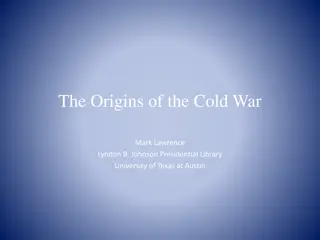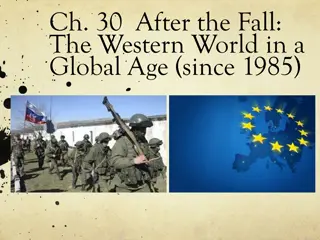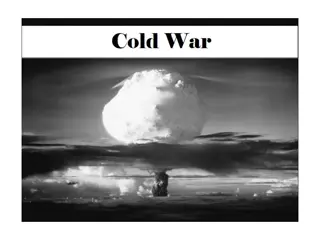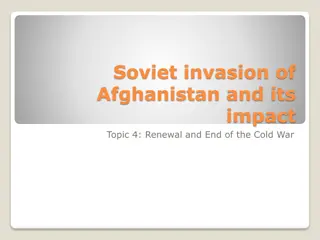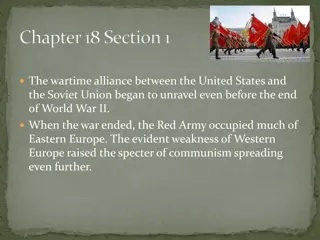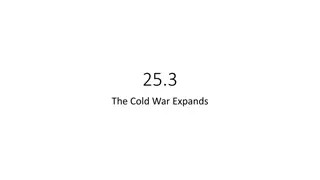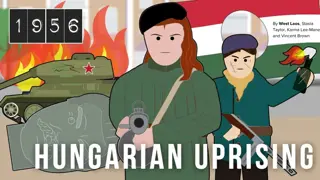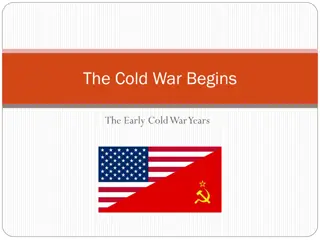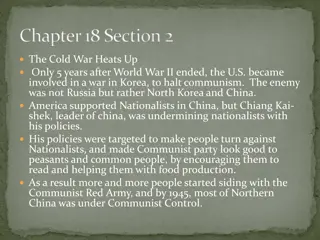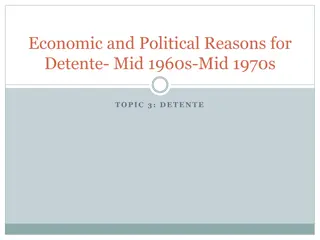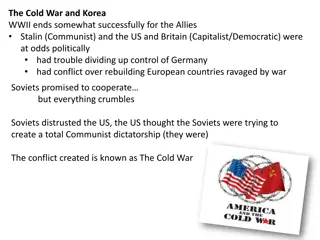The Collapse of Communism and the Soviet Union: A Historical Overview
The collapse of communism in the Soviet Union was influenced by factors such as a home-grown insurgency, the rise of the Polish trade union Solidarity, and the reforms initiated by Mikhail Gorbachev. Solidarity, led by Lech Walesa, played a significant role, supported by the Catholic Church. Gorbachev's policies of Glasnost and Perestroika led to a new approach in governance, ending Soviet domination over Eastern European states.
Uploaded on Sep 12, 2024 | 2 Views
Download Presentation

Please find below an Image/Link to download the presentation.
The content on the website is provided AS IS for your information and personal use only. It may not be sold, licensed, or shared on other websites without obtaining consent from the author. Download presentation by click this link. If you encounter any issues during the download, it is possible that the publisher has removed the file from their server.
E N D
Presentation Transcript
The Collapse of Communism & the Soviet Union
Union of Soviet Socialist Republics 15 Republics: Armenia, Azerbaijan, Belarus, Estonia, Georgia, Kazakhstan, Kyrgyzstan, Latvia, Lithuania, Moldova, Russia, Tajikistan, Turkmenistan, Ukraine, Uzbekistan Eastern Bloc 6 Satellite Countries: Czechoslovakia, East Germany, Hungary, Poland, Bulgaria, Romania
A Home-Grown Insurgency Massive, home- grown insurgency contributed to the collapse
Polish Trade Union: Solidarity Downfall began in 1980 when striking Polish workers organized Solidarity, an independent trade union of nearly 10 million members.
Support from Catholic Church Solidarity, had strong support from the powerful Polish Catholic Church.
Solidaritys Chairman: Lech Walesa Polish military drove Solidarity underground in 1981. In 1990, he would be the first freely elected president of Poland in more than sixty years.
The Gorbachev Revolution Mikhail Gorbachev, came to power in 1985 as leader of the Soviet Union, recognized the Soviet system had to be changed if it was to survive.
Gorbachev's Plan 1. Glasnost (openness) greater freedom of expression 2. Perestroika (restructuring) of the Soviet economy with gradual market reforms 3. Renunciation of the Brezhnev Doctrine (armed intervention where socialism was threatened) and the pursuit of arms control agreements
Release from Soviet Domination Renunciation of the Brezhnev Doctrine: Eastern European states free from Soviet domination. Communist rulers of these states could not survive without the support of the Soviet Union. The Brezhnev Doctrine was articulated in 1968 when the Soviet army occupied Czechoslovakia to end the Prague Spring, an attempt by Alexander Dubcek to build socialism with a human face.
Wave of Demonstrations In September 1989, a wave of huge demonstrations shook Communist regimes across eastern Europe. http://www.spiegel.de/img/0,1020,1463297,00.jpg
http://www.spiegel.de/img/0,1020,1463306,00.jpg A tram is blocked by East German demonstrators in the center of the city in October 1989. Their banner reads: 'Legalization of opposition parties, free democratic elections, free press and independent unions.'
The Berlin Wall Came Down On the night of November 9, 1989, ordinary Germans poured through the Berlin Wall. October 1990, Germany reunified after 41 years apart
Events in Eastern Europe In 1990, Communist governments in Czechoslovakia, Hungary, & Bulgaria fell after democratic elections.
Radical Change in the USSR August 1991: thousands of Russian citizens poured into the streets to defeat a coup d' tat & keep their new freedoms.
Independent Republics, December 1991 The Communist party collapsed, & the Soviet Union began process of reorganizing itself as a loose confederation of independent republics.
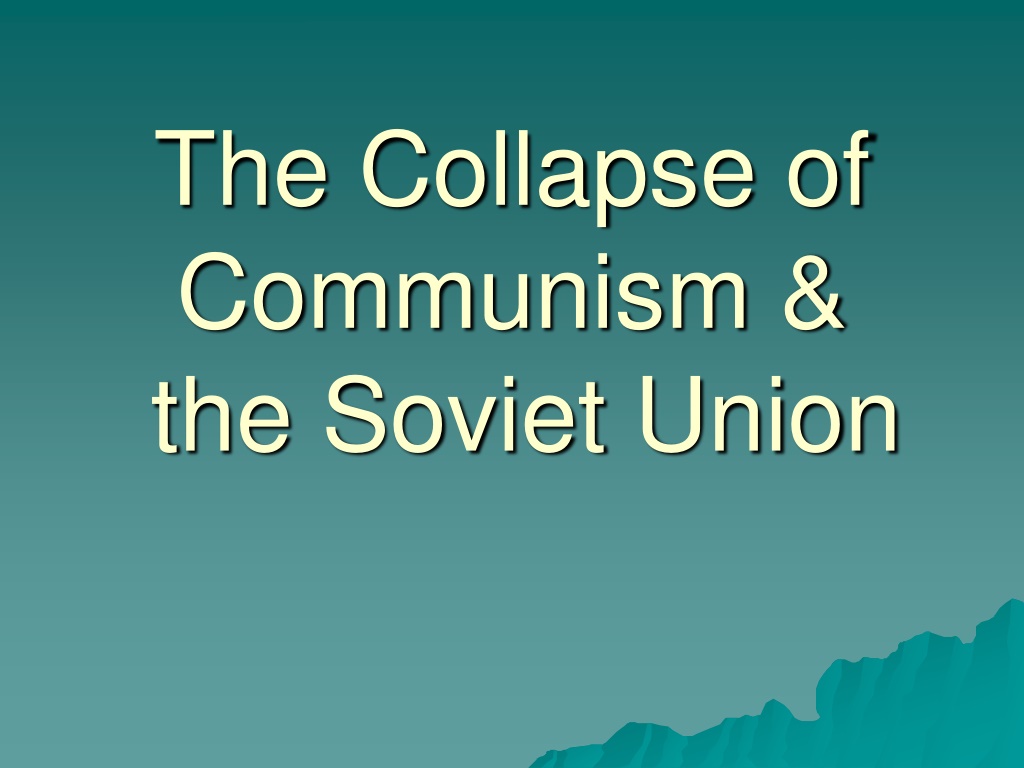
 undefined
undefined

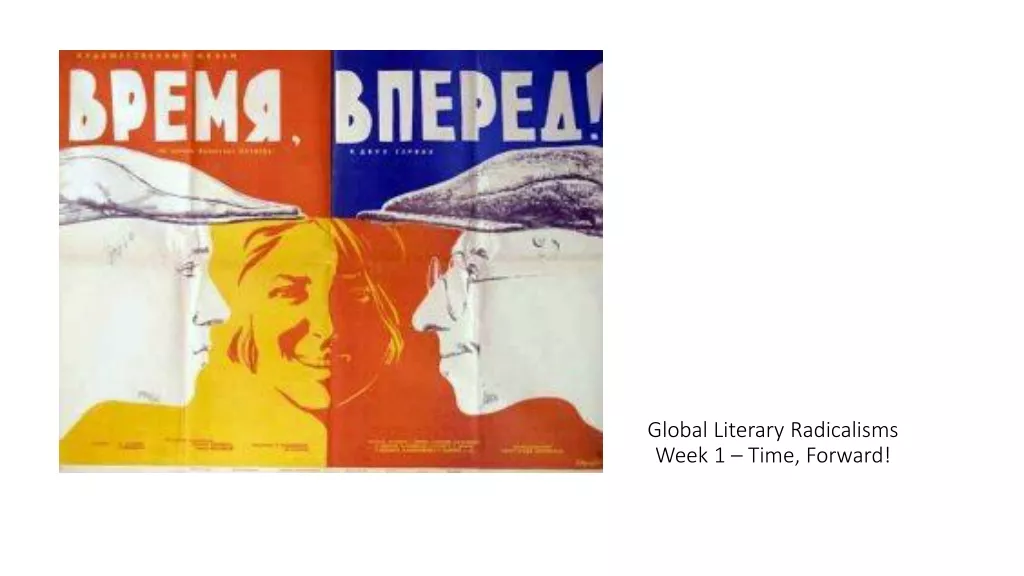
![[PDF⚡READ❤ONLINE] Energiya-Buran: The Soviet Space Shuttle (Springer Praxis Book](/thumb/21613/pdf-read-online-energiya-buran-the-soviet-space-shuttle-springer-praxis-book.jpg)

